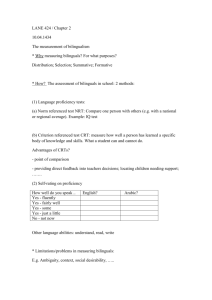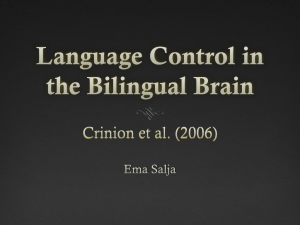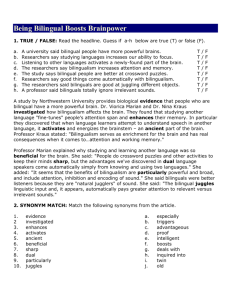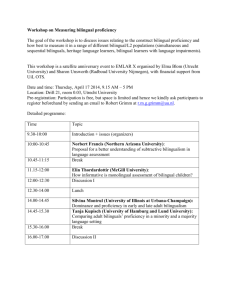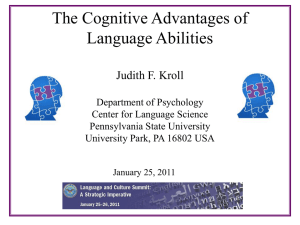Introduction to Special Issue: The Measurement of Bilingual
advertisement
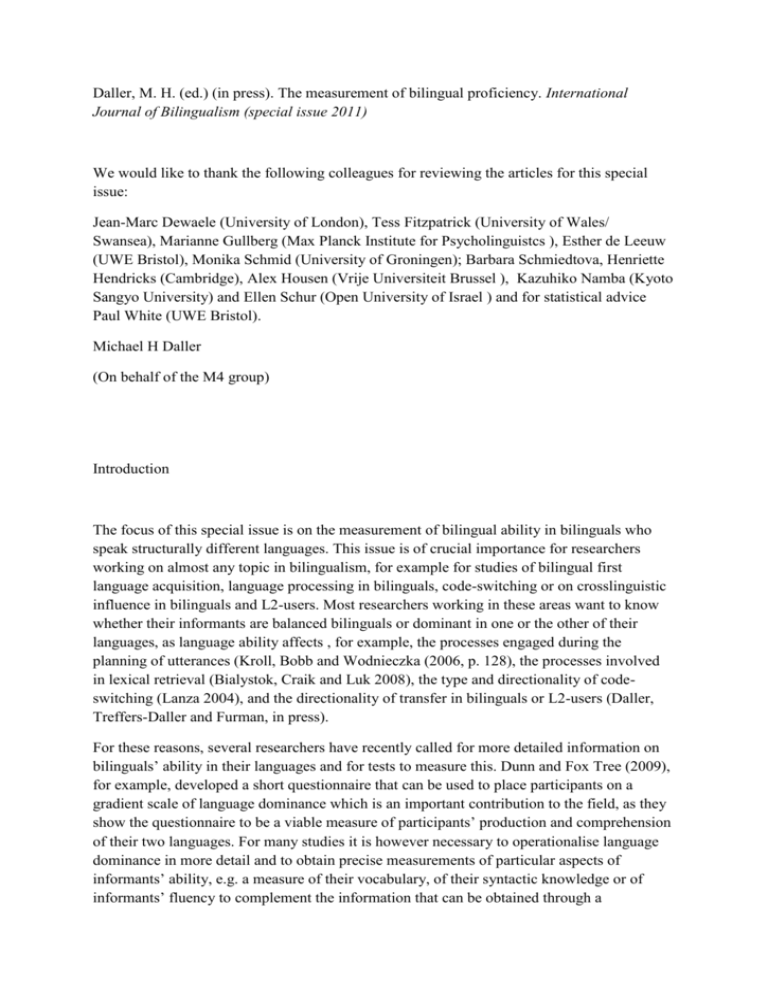
Daller, M. H. (ed.) (in press). The measurement of bilingual proficiency. International Journal of Bilingualism (special issue 2011) We would like to thank the following colleagues for reviewing the articles for this special issue: Jean-Marc Dewaele (University of London), Tess Fitzpatrick (University of Wales/ Swansea), Marianne Gullberg (Max Planck Institute for Psycholinguistcs ), Esther de Leeuw (UWE Bristol), Monika Schmid (University of Groningen); Barbara Schmiedtova, Henriette Hendricks (Cambridge), Alex Housen (Vrije Universiteit Brussel ), Kazuhiko Namba (Kyoto Sangyo University) and Ellen Schur (Open University of Israel ) and for statistical advice Paul White (UWE Bristol). Michael H Daller (On behalf of the M4 group) Introduction The focus of this special issue is on the measurement of bilingual ability in bilinguals who speak structurally different languages. This issue is of crucial importance for researchers working on almost any topic in bilingualism, for example for studies of bilingual first language acquisition, language processing in bilinguals, code-switching or on crosslinguistic influence in bilinguals and L2-users. Most researchers working in these areas want to know whether their informants are balanced bilinguals or dominant in one or the other of their languages, as language ability affects , for example, the processes engaged during the planning of utterances (Kroll, Bobb and Wodnieczka (2006, p. 128), the processes involved in lexical retrieval (Bialystok, Craik and Luk 2008), the type and directionality of codeswitching (Lanza 2004), and the directionality of transfer in bilinguals or L2-users (Daller, Treffers-Daller and Furman, in press). For these reasons, several researchers have recently called for more detailed information on bilinguals’ ability in their languages and for tests to measure this. Dunn and Fox Tree (2009), for example, developed a short questionnaire that can be used to place participants on a gradient scale of language dominance which is an important contribution to the field, as they show the questionnaire to be a viable measure of participants’ production and comprehension of their two languages. For many studies it is however necessary to operationalise language dominance in more detail and to obtain precise measurements of particular aspects of informants’ ability, e.g. a measure of their vocabulary, of their syntactic knowledge or of informants’ fluency to complement the information that can be obtained through a questionnaire. Operationalising language dominance is highly relevant in a number of areas such as educational research, applied linguistics and psycholinguistics but it is notoriously difficult to achieve since many bilinguals, in particular those living in an immigrant setting, use in their every day life two or more languages with large structural differences (e.g. French/ Arabic, English/Mandarin, Dutch/ Turkish and other pairs). It is a particular challenge to measure bilingual ability in these language pairs, because it is difficult to ensure that measures of, for example, syntactic proficiency are comparable across the languages. A thorough methodological approach is necessary in order to avoid flawed measures, which could have severe consequences for bilingual subjects in their school or academic career. The authors of this special issue face this challenge and argue for reliable and valid measures from very different angles: processability theory, macrostructural planning in narratives, bilingual gestures, the measurement of vocabulary knowledge or the measurement of fluency. Each of these approaches allows us to obtain deeper insight into bilingual ability in general and into bilingual dominance specifically and it is hoped that a combination of different approaches will allow us to draw a more fine-grained picture of bilingual ability than was previously possible. The first contribution in this special issue by Pienemann, Keler and Itani-Adams shows how comparisons can be made between different languages with the “Rapid Profile” which is a measurement tool based on the framework of the Processability Theory (PT). PT predicts universal syntactical and morphological developmental trajectories that apply to any language and based on it a comparative metric for any given language pair can be developed. The authors outline briefly the general concept of PT and then apply it to the language pair Japanese-English. They show how PT can be applied to these typologically different languages and how this approach can be used to compare developmental patterns of a bilingual child. The authors give further examples of other settings where this approach has been used successfully, e.g. with early Turkish-German bilinguals, and they explain how this approach can be applied to bilingual language combinations where no previous research within this framework is available. Pienemann and colleagues show that it is possible to overcome methodological difficulties in the comparison of structurally different languages and that their approach it is applicable in various contexts. Bilinguals who reach the endpoint of their syntactical development in their two languages will be qualified as equally high proficient with the “Rapid Profile”. However, this does not necessarily mean they have reached the endpoint at other levels of their acquisition trajectories. Measures which tap into other dimensions of language ability, such as vocabulary, are needed to give a deeper insight into the ability of these bilinguals. A study with bilinguals that are highly proficient in both languages is provided by Treffers-Daller. The methodological challenge in this study is that some of the adult bilinguals are not fully literate in one of their languages, and that therefore tools for the analysis and comparison of spoken data are necessary. The study addresses this problem by operationalising the notion of language dominance with an analysis of oral descriptions of picture stories by two different bilingual groups. One group are French-English bilinguals from Paris and one group are French-Dutch bilinguals from Brussels where the latter speak a local Dutch variety that is hardly ever written. The oral data of the informants are analysed with two measures of lexical richness: “D” (Malvern and Richards, 1997) and the “Index of Guiraud” which can both computed with the help of CLAN, a computerised data analysis tool (MacWhinney, 2000). Treffers-Daller provides detailed information on the use of this tool, including on ways of lemmatising data from a language (Brussels Dutch) for which no readymade lexicon exists in CLAN. Treffers-Daller analyses the lexical richness of oral picture descriptions and identifies four different dominance patterns amongst the bilinguals in her study. She cross-validates her categorisation with the analysis of linguistic features that are typical for a specific proficiency levels such as the use of prefabricated formulas (il ya a ... qui/ there is a ... who/which) for the introduction of new referents. This type of formulaic sequences is typical for narratives of French-speaking children and turns out to be more predominant in bilinguals with French as the weaker language than French-dominant bilinguals in Treffers-Daller’s study. This approach is in line with the study by Flecken, which follows Treffers-Daller’s, where the use of specific narrative patterns reveals language dominance patterns in bilinguals. Flecken shows that language dominance patterns can be traced in bilinguals (simultaneous acquisition of both languages from age 4 or below) with a high proficiency in closely related languages (Dutch and German). The participants in her study were all adolescents or adults who had acquired Dutch and German simultaneously from the age of 4 or below. Her study is based on narratives elicited with silent films and the variables she investigates are language-specific patterns of micro- and macro- planning such as information selection, thematic continuity, referential framing and temporal and spatial terms. None of the bilingual narratives violate grammatical rules of either language but the preferences for certain patterns reveal dominance in one of the languages. An example of the subtle differences between the two languages is a preference for “topic deletion” (the omission of the subject) in monolingual German narratives, whereas monolingual Dutch narratives have a tendency to use pronouns in these context. The point is that both constructions are possible in Dutch and German but that these languages differ in the frequency of the use of these patterns. Individuals can then be classified as being more Dutch or more German dominant. Flecken also shows that there are unique bilingual-specific patterns of reference management that are, however, grammatical in both languages. The unique contribution of Flecken’s study lies in the fact that even in highly proficient bilinguals who use closely related languages subtle dominance patterns can be traced. Cremer, Dingshoff, de Beer and Schoonen compare word associations in L1 and L2 in children and adults. Their study gives valuable insights into the relationship between word associations and age on the one hand and word associations and language background on the other hand. In a large scale study they elicited more than 30.000 word associations from more than 400 participants. The authors show that the language background of the participant explains some of the differences in word association patterns, but that age and cognitive maturation play a much more important role both in L1 and L2. Adult L2 learners most likely resort to their semantic or conceptual knowledge developed in the L1. Age is the most dominant factor in response patterns in meaning-related associations, which is the major category in the present study and accounts for more than 90% of the associations. Whereas many studies on bilinguals focus on differences between groups, Cremer et al. show that there are important similarities between L1 and L2 users of the same age group. Adult L1 and L2 users especially, show clear similarities in their association patterns. Although the authors do not mention language dominance explicitly, the similarities between L1 and L2 users in the same age group suggest that free word associations are not per se a useful tool to measure word knowledge in either language. Free association responses can show the strength of certain word relations but they are indicative of (recent) exposure rather than ‘good’ or ‘not so good’ word knowledge. This is a valuable finding for research in language dominance and the comparison of proficiency in two languages. The present state of the art does not allow word associations to be used as measures of language dominance. However, the findings of Cremer et al. give some indications for future research in this field. Nagpal, Nicoladis and Marentette investigate the use of gestures in both languages of bilingual participants who did not acquire these languages from a very early age but where brought up with Hindi in India with English as foreign language and immigrated to Canada in their early adulthood. They had been living in Canada for about 2.8 years at the time of the data collection. Therefore, this study focuses on bilinguals with a language acquisition history that is quite different from the subjects discussed in the preceding articles. The main question Nagpal’s et al. study is whether there is a relation between the number of gestures in the two languages or not. This is interesting from a theoretical viewpoint since some gesture types seem to support lexical access of the speaker. These are mainly iconic gestures that resemble the referent in the spoken language, e.g. hand movements referring to the size of an object. If the Lexical Access Hypothesis is true then more of these gestures will be used in the weaker language of a bilingual because lexical access is more difficult in the non-dominant language. This would make it possible to define language dominance on the basis of the amount of iconic gestures used. Alternatively there could be individual gesture preferences that influence the use of gestures in both languages. In order to investigate this further the authors establish the language proficiency of the participants in English with teacher judgements and a measure of fluency (words per second). Their findings show that proficiency is not significantly related to the number of gestures. However, the high correlation between the gesture rates in both languages indicates the importance of individual preferences and communicative styles. Therefore the study does not directly support the Lexical Access Hypothesis and stresses the importance of underlying preferences that influence the performance in both languages of a bilingual. The importance of these findings for the discussion on language dominance lie in the fact that it is more likely to reveal dominance patterns in verbal rather than non-verbal communication at least in a setting where the second language is acquired quite late. Finally, Daller, Yıldız, de Jong, Kan and Başbağı show that simple measures of fluency can reveal language dominance in bilinguals. These measures can be based on automated procedures with the programme “Praat” that do not require any transcription of the spoken data. The authors compare oral narratives (descriptions of picture stories) of GermanTurkish bilinguals with narratives of a control group of Turkish monolinguals who acquired German as a foreign language at school. Both groups have different dominance patterns which can be shown with an established test in both languages. The control group is clearly Turkish-dominant whereas the bilinguals are German-dominant. Two indices of dominance were computed both manually and automated with the programme Praat: words per second and total amount of performance in each language. The validity of these indices is then analysed with a logistic regression where up to 90 % of group membership can be predicted and further corroborated with a discriminate analysis and a “leave-on-out classification” for group membership. This approach, as well as the “Rapid Profiler” in the first article of this special issue, are universal in the sense that they have the potential to compare language proficiency and language dominance between any given language pair. The difference between the two is that the “Rapid Profiler” is based on a elaborate linguistic theory (PT) whereas an automatic analysis of fluency is based on a simple count. However, the conclusion that one of these two approaches could replace the other would be misplaced since language dominance is a construct that cannot be directly measured. Different measures should complement each other to reduce the amount of “nomological noise” (Messick 1989 :48). It is hoped that this special issue will make its contribution towards the discussion about multiple measurements in research on bilingual proficiency. Michael H. Daller Bialystok, E., Craik, F.I.M., & Luk, G. (2008). Cognitive control and lexical access in younger and older bilinguals. Journal of Experimental Psychology: Learning, Memory, and Cognition, 34, 859-873. Daller, M.H., Treffers-Daller, J. and Furman, R. (in press). Transfer of conceptualisation patterns in bilinguals: the construal of motion events in Turkish and German. In Jarvis, S. (ed.). Bilingualism, Language and Cognition. Dunn, A.L. and Fox Tree, J. E. (2009) A quick, gradient Bilingual Dominance Scale. Bilingualism: Language and Cognition, Vol 12 (3), 273 – 289. Kroll, J. F., Bobb, S., & Wodniekca, Z. (2006). Language selectivity is the exception, not the rule: Arguments against a fixed locus of language selection in bilingual speech. Bilingualism: Language and Cognition, 9, 119-135. Lanza, E. (2004). Language Mixing in Infant Bilinguals. A Sociolinguistic Perspective. Oxford: OUP. MacWhinney, B. (2000). The CHILDES project: Tools for analyzing talk (3rd ed., Vol. 1 and Vol. 2). Mahwah, NJ: Erlbaum. Malvern, D. D. and Richards, B. J. (1997). A new measure of lexical diversity. In: Ryan, A. and Wray, A. (Eds.) Evolving Models of Language (Papers from the Annual Meeting of the BAAL held at the University of Wales, Swansea, September 1996). Clevedon: Multilingual Matters, 58-71.
